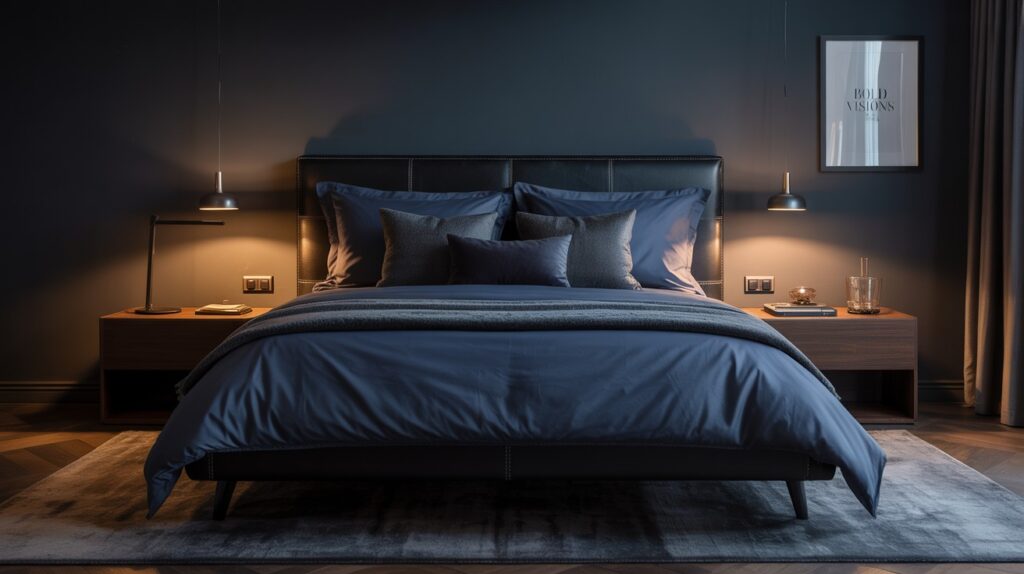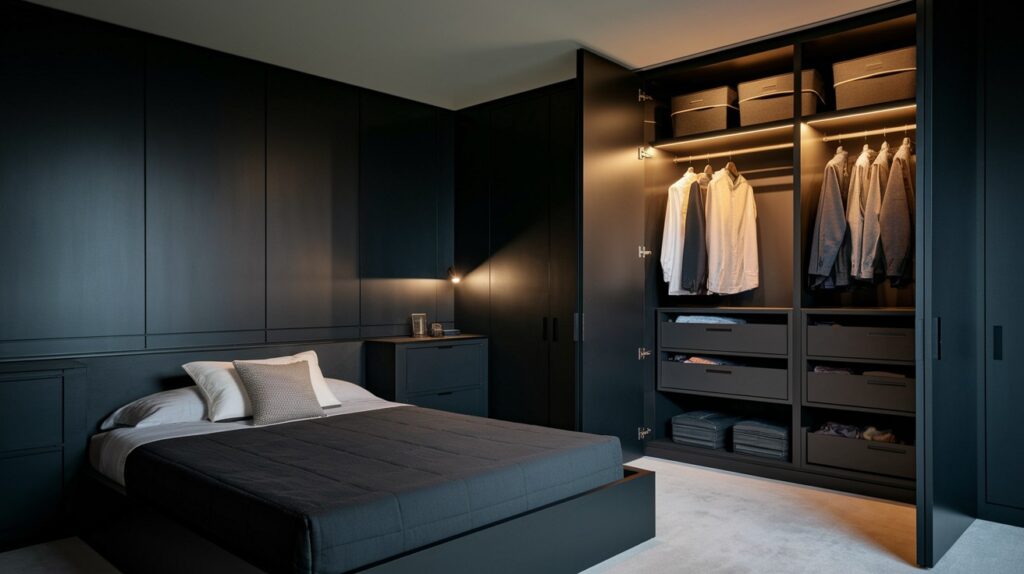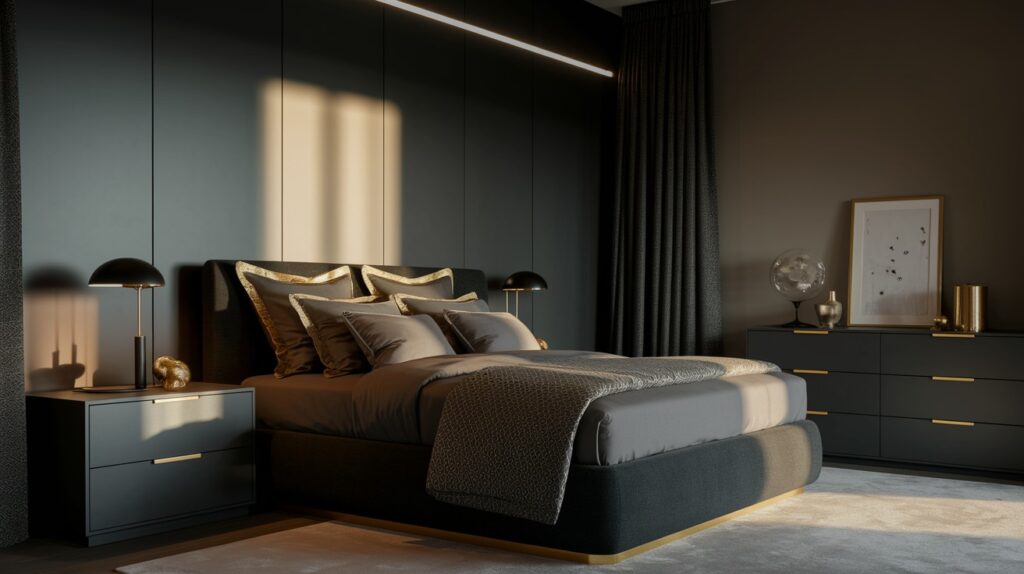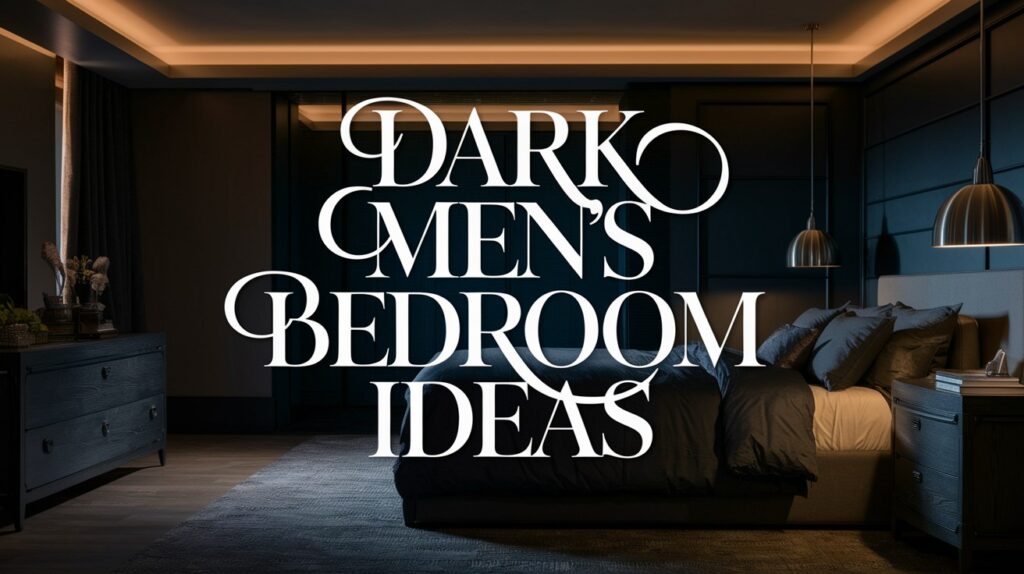Your bedroom should feel like your space. Dark colors make that happen.
Many men want a room that looks grown-up and feels relaxing. Dark tones do both. They create a mood that’s calm but bold. Think deep blues, charcoal grays, and rich blacks.
This guide shows you how to build a masculine bedroom using dark colors. You’ll learn about paint choices, furniture picks, and lighting tricks. We’ll cover everything from bedding to wall art.
These ideas come from real bedroom makeovers and design experts. No fluff or trendy tricks that won’t last.
By the end, you’ll know exactly how to create a space that feels both sophisticated and comfortable. Your bedroom will become the retreat you want to spend time in.
Why Go Dark? The Appeal of Deep, Moody Bedrooms

Dark bedrooms aren’t just trendy. They’re smart.
Your brain relaxes faster in darker spaces. The deep colors create a cocoon effect that signals it’s time to wind down. Think of it like your own personal cave, a place where you can shut out the world.
Men gravitate toward these bold color choices because they feel substantial. There’s something powerful about walking into a room that doesn’t apologize for taking up space. Dark walls make a statement without saying a word.
Bachelor pads and modern apartments love this look. It’s sophisticated without being fussy. Clean lines meet rich colors, and the result feels both comfortable and impressive.
The psychology is simple: darker tones ground you. They create stability in a world that often feels chaotic. Your bedroom becomes a retreat that helps you sleep better.
Choose the Right Dark Color Palette

Not all dark colors work the same way.
Charcoal gray is your safe bet. It’s neutral enough to work with almost anything, but dark enough to create that moody atmosphere you’re after. Navy blue adds sophistication, think of it as the gentleman’s choice.
Espresso brown brings warmth. It’s rich without being overwhelming. Matte black is bold, but use it sparingly unless you want to feel like you’re sleeping in a cave.
Forest green is the wild card. It’s masculine but unexpected. Pair it with natural wood, and you’ve got something special.
For accents, think gold hardware and tan leather. These warm tones prevent your space from feeling cold. Deep burgundy works as an accent color, especially in textiles.
Gray is your bridge color. Use it to connect different dark tones and keep things cohesive.
The key is balance. Too much dark, and you’ll feel trapped. Mix in lighter accents to give your eyes a place to rest.
Walls That Set the Mood

Your walls are the foundation of everything else.
Matte paint finishes absorb light, creating depth and hiding imperfections. Satin finishes reflect just enough light to keep things from feeling flat. I recommend matte for most situations – it’s more forgiving and looks expensive.
Wallpaper isn’t just for grandmothers anymore. Dark geometric patterns add visual interest without being busy. Textured wallpapers create a dimension that plain paint can’t match.
Wood paneling screams masculinity. Dark-stained wood or even painted wood panels add texture and warmth. Stone accent walls work too, especially behind the headboard.
Consider which wall gets the most attention. Usually, it’s the one behind your bed. Make that your statement wall, and keep the others simpler.
Remember: you’re creating a mood, not a dungeon. The right wall treatment sets the tone for everything else in the room.
Furniture with Bold Character

Your furniture should look like it belongs to a grown man.
Clean lines beat ornate details every time. Look for pieces that feel substantial without being bulky. Black furniture works, but dark wood feels warmer and more approachable.
A leather headboard is a game-changer. It’s comfortable, durable, and gets better with age. Skip the tufted look – go for smooth, simple panels instead.
Industrial nightstands made from metal and wood hit the sweet spot between functional and stylish. They’re practical but have personality.
Dressers should be low and wide rather than tall and narrow. This creates better proportions in your space and makes the room feel more expansive.
Look for pieces that pull double duty. Ottoman storage, beds with built-in drawers, or nightstands with shelves help keep clutter at bay.
Quality matters more than quantity. A few well-chosen pieces always beat a room full of cheap furniture.
Lighting: The Key to Balance

Lighting can make or break a dark room.
You need multiple light sources. One overhead light isn’t enough. Think layers: ambient lighting for general illumination, task lighting for reading, and accent lighting for mood.
Warm light bulbs (2700 K- 3000 K) soften dark colors and create a cozy atmosphere. Cool white light makes dark rooms feel harsh and unwelcoming.
Bedside lamps are non-negotiable. Choose ones with adjustable brightness if possible. Wall-mounted sconces free up nightstand space and look modern.
Statement light fixtures can be your room’s personality. A matte black pendant light or a geometric chandelier adds visual interest without overwhelming the space.
Don’t forget natural light. If you have windows, work with them. Heavy curtains can block light when you need darkness, but make sure you can open them during the day.
Table lamps and floor lamps create pools of light that add warmth and depth to your space.
Textiles That Add Texture and Warmth

Texture is what makes a dark room feel inviting instead of cold.
Your bedding is the biggest textile opportunity. Linen feels relaxed and modern. Velvet adds luxury but can be high-maintenance. Cotton blends offer the best of both worlds – comfort and durability.
Layer different textures. A smooth duvet with a chunky knit throw creates visual interest. Add a few throw pillows in different materials, but don’t go overboard.
Rugs ground the space and add warmth underfoot. A large rug that extends beyond the bed makes the room feel larger. Stick to dark tones with subtle patterns.
Window treatments matter too. Heavy curtains in dark colors help with light control and add to the moody atmosphere.
Patterns should be subtle. Stripes, chevron, or herringbone work well in dark tones. Avoid busy patterns that compete with your color scheme.
Quality textiles feel better and last longer. They’re worth the investment.
Wall Art and Decor That Speaks Masculine Style

Your walls need personality, but keep it masculine.
Abstract art works well in dark rooms. Bold brushstrokes and simple compositions complement the clean lines of masculine design. Black and white photography is classic and timeless.
Metal wall art adds texture and reflects light. Look for pieces with geometric shapes or industrial themes.
Personal touches make the space yours. Travel photos, vintage finds, or sports memorabilia tell your story. But be selective, a few meaningful pieces beat a cluttered gallery wall.
Size matters. One large piece often looks better than several small ones. If you do group pieces, keep them related in theme or color.
Mirrors can help brighten a dark room while serving a practical purpose. Choose ones with interesting frames that complement your style.
Keep it minimal. Let each piece breathe instead of cramming every surface with decorations.
Greenery and Natural Elements for Contrast

Plants bring life to dark spaces.
Snake plants and ZZ plants thrive in low light and require minimal care. They’re perfect for men who want greenery without the commitment of high-maintenance plants.
The contrast between dark walls and green plants creates visual interest. Plants also improve air quality and add a natural element to an otherwise designed space.
Wood accents warm up dark rooms. A wooden bench at the foot of the bed or floating shelves add texture and break up solid colors.
Stone elements, like a small accent wall or decorative object, add rugged charm. Metal accents in brass or copper bring warmth and shine.
Natural light is still important. If you have windows, make the most of them. Sheer curtains can filter light while maintaining privacy.
These natural elements prevent your dark room from feeling artificial or cold.
Smart Storage and Clutter-Free Zones

A masculine bedroom should feel organized and intentional.
Built-in storage looks custom and maximizes space. Under-bed storage boxes keep seasonal items out of sight and out of mind. A well-organized closet prevents clothes from cluttering the floor.
Minimalism isn’t about having nothing – it’s about having the right things. Every item in your room should serve a purpose or bring you joy.
Declutter regularly. If you haven’t used something in six months, consider whether you need it. Clear surfaces make a room feel larger and more peaceful.
Invest in quality storage solutions. A good dresser with deep drawers beats multiple cheap organizers. Hooks on the back of doors provide quick storage for jackets or bags.
Keep your bedside table clear except for essentials. A lamp, a book, and maybe a small dish for keys or a wallet.
Function should never be sacrificed for form. A beautiful room that doesn’t work for your lifestyle won’t make you happy.
Finishing Touches for a Cohesive Look

The details make the difference.
Your color scheme should flow throughout the room. If you chose charcoal and gold, stick with it. Consistency creates sophistication.
Scented candles or a diffuser add another sensory layer. Choose scents that feel masculine – cedar, sandalwood, or fresh linen work well. Avoid anything too sweet or floral.
Hardware matters. Drawer pulls, lamp switches, and picture frames should complement each other. Matte black, brushed brass, or dark bronze all work well with masculine color schemes.
Step back and look at the room as a whole. Does everything feel intentional? Are there any elements that don’t belong?
Sometimes, less is more. If something doesn’t add to the overall feel, remove it.
Remember that this is your space. It should reflect your personality while creating the atmosphere you want. The best masculine bedrooms feel both designed and lived-in.
Trust your instincts. If something feels right, it probably is.
Conclusion
Creating a dark, masculine bedroom isn’t about following rules perfectly. It’s about building a space that feels right for you.
Your bedroom should work for your life. If you read in bed, prioritize good lighting. If you need storage, make that a focus. Function always comes first.
Remember that masculinity in design isn’t about being harsh or cold. The best masculine spaces feel strong but welcoming. They’re places where you can relax and recharge.
Dark colors create atmosphere, but balance keeps them livable. Layer in textures, warm lighting, and personal touches to make the space truly yours.
Most importantly, ignore anyone who tells you dark bedrooms are too bold or impractical. If you love the look and it makes you feel good, that’s all that matters.
Your bedroom is your sanctuary. Make it a place you want to spend time in.
Frequently Asked Questions
Will a dark bedroom make me feel depressed or claustrophobic?
Not if you balance it properly. Use warm lighting, add textiles for texture, and include lighter accent colors. Dark bedrooms help many people sleep better by creating a cozy atmosphere. If you’re concerned, start with one dark accent wall instead of painting everything.
How do I keep a dark bedroom from looking too small?
Use multiple light sources at different heights to create depth. Add mirrors to reflect light and expand the space visually. Choose low, streamlined furniture over tall, bulky pieces. A large area rug helps create visual flow and makes the room feel more spacious.
What’s the best way to add color without ruining the masculine vibe?
Stick to rich, deep accent colors like burgundy, forest green, or navy blue. Metallics such as brass, copper, or matte gold add warmth. Earth tones like tan, camel, or rust complement dark bases well. Avoid pastels or bright colors that clash with the moody atmosphere.
Can I use dark colors in a bedroom with limited natural light?
Yes, but focus on layered artificial lighting. Use table lamps, floor lamps, and overhead fixtures with warm bulbs (2700 K- 3000 K). Add lighter bedding or strategic light-colored accessories to reflect available light. Well-lit dark rooms often feel more intimate than poorly lit bright ones.
How much should I expect to spend to create this look?
Start small and build gradually. Quality dark paint costs $50-80 and transforms the entire room. Focus on one major piece first, like a headboard or quality bedding, then layer over time. Check thrift stores and online marketplaces for affordable masculine furniture pieces.

